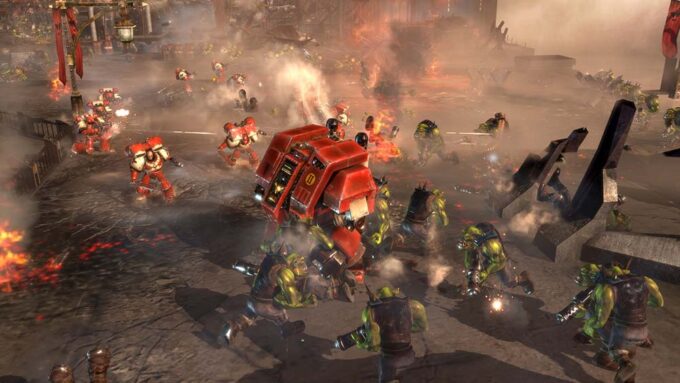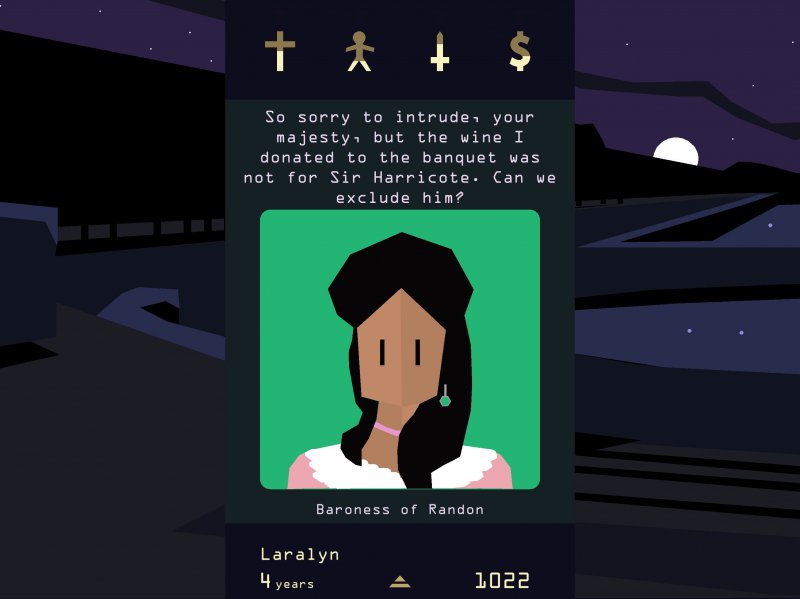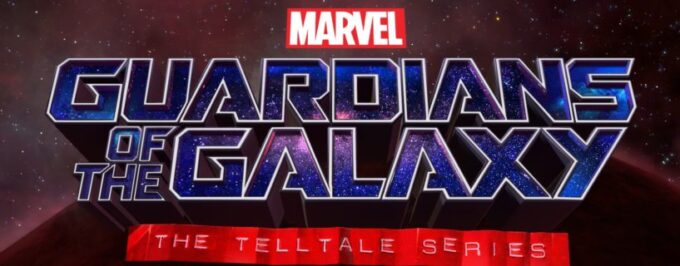Fans of the epic universe Warhammer 40,000 waited for the release of the third part of the famous strategy Dawn of War. Developers from Relic Entertainment have tried to combine all the best that they came up with in previous games, to give it a sound history, to ennoble with modern graphics, to stuff more mass battles and not forget about the balance of factions. And it turned out they have it or not, you will learn from our review.
The central characters in the plot of Warhammer 40,000: Dawn of War III were the characters of the first part – the head of the Order of Space Marines “Blood Ravens” Gabriel Angelos, Eldar Mach, the visionary raceman and the Oroch military leader Gorgutz. All of them want to take possession of the warp-flying planet Acheron, which should appear in space near the Kiprus-Ultima system. The three warring races are attracted not by the flying world itself, but by what is on it. The ultimate goal of the campaign, battles and battles is the spear of the war god Eldar Khein. According to legend, it gives the owner incredible power and is able to crush the enemies with one blow. Of course, the parties do not come to a common opinion about the future of the possessor of powerful weapons, and this leads to a military conflict.
The fight for the artifact
The plot campaign is not boring, but there are not enough stars from the sky. For seventeen missions, gamers have to play for three factions, learn their features, strengths and weaknesses and find out for themselves which race to give preference to in multiplayer. Each mission contains the same set of actions: we build and develop the base, create different types of troops, strengthen them, capture points with resources and destroy one or more enemy bases. At the same time, we are shown that some types of troops are able to do what helps strengthening weapons and armor, and for which it is necessary to capture as many points as possible with resources.
The development of the base is not profound, therefore in fact each faction has access to the main building, barracks for the troops, a surveillance tower, a building to improve technology and a pair of unique fractional structures.
In the first campaign they give to play for Space Marines. They are the easiest to manage, they have balanced damage and medium protection. The faction of the faction is massive orbital strikes against enemies. In addition, Space Marines are able to call for assistance to troops anywhere on the map.
After the brave sons of humanity, gamers are left to control cheerful and otvyaznyh orcs. Green-skinned halftones know how to collect scrap metal, create new combat units from it, or improve existing troops. In addition, the orcs build special “vaaghkh” towers, which for a short time raise the combat performance of the army and make of it a fearless horde. Of the minuses, weak in combat, but expensive in the production of flying equipment of orcs, stands out.
After this, the campaign issues under the control of the gamer race Eldar. Space elves received weak armor, but they are able to transfer their structures on the map and teleport troops from one structure to another. In addition, the Eldar build special buildings that give the troops a shield and increase the speed of movement of units. The strength of this faction is powerful long-range attacks.
The gamer moves from mission to mission, alternately playing for each faction, delves into the plot twists and turns and understands the logical and just motivation of the three main characters. If Angelos takes possession of the artifact, he will kill two birds with one stone – he will avenge Mahe for the disagreement of the past and will receive a formidable weapon. Seeing the Eldar rightly believes that the spear of the Eldar god of war should belong to the space elves, and the orc Gorgutz simply likes to fight. And if there is still a chance to get hold of an important relic of the pale-skinned Eldar, the orcish warboss will do everything to do it.
The Ecumenical Conflict
After several story campaigns and familiarity with the basics of the updated gameplay, features of the new project are traced. Immediately striking is the developers’ attempt to please the fans of the two parts and make a product for everyone. Yes, in Warhammer 40,000: Dawn of War III, the basement was rebuilt, but it was cut short. What kind of creation of a military nest is it, if five types of structures are available for construction?
On the other hand, the developers have added more combat units, units, ground and air support, heroes and huge super-warriors. But somewhere branded for the second part of the shelter. From them there was only a pale shadow in the form of special places on the map, where your or enemy detachments can not be found, or special fortified structures, which after the capture give an energy shield, but do not protect against melee. In addition, the army was deprived of individuality, and the squads removed the pumping and the availability of equipment. Rocking and getting new skills are just heroes. But left a pair of special skills on the squad, and each type of troops they have.
Despite the increase in the scale of the battles, simply to create as many different detachments as possible, to improve their weapons and armor, and then to bring down to the enemy all the firepower of the faction, will not come out. Half of the army will be destroyed in a couple of minutes, and the second part will have to be quickly withdrawn. On the battlefields Dawn of War III everything is decided by microcontrol.
A piece of the success of any battle is to learn the skills and capabilities of each type of troops, to learn how to combine them into mini-groups, and then advance, to thinkfully apply active skills. At the same time, we must not forget about the strength of the heroes, their capabilities and weaknesses. The easiest way to start at the beginning is to play Space Marines – they are more or less able to hold a blow, if you forget to take them from their positions, cause serious damage to the pumped flamethrowers or blasters and have a significant plus in the form of orbital fire.
Closer to the end of the plot tasks on the scene are the superworld in the form of the Imperial Knight of the Space Marines, the Phantom Lord of the Eldar and the Oroch Stomp of the greenskins. These warriors occupy half the screen, inflict incredible damage and annihilate all enemy troops in a matter of minutes. After that, the balance of the battle is finally collapsing, and the tactics of missions are reduced to one – to hold out with a minimum of troops, accumulate resources, create a super monster and bring down its power to the adversary.
In online battles, one-on-one, two-on-two and three-on-three battles are available. The truth at the start of the mode there is only one, although it is played on different cards. The essence of multiplayer is simple – on your and enemy bases there are energy cores. There are two roads leading to them, where a shield generator and a protective turret are installed. The one who will pass the line of obstacles and destroy the enemy’s energy core will win. Usually, both sides save resources for elite units, ignore other types of troops and any tactics. Naturally, the winner is the one who will build stronger units faster, spread the defensive line of the enemy and get to the core. Of course, there are exceptions, but the basis of the multiplayer is as follows. The game needs new modes in future additions, because such a MOBA-brawl has all the chances to quickly get bored of players.
The beauty of the epic world
Warhammer 40,000: Dawn of War III received a beautiful and slightly cartoon picture. Spells of heroes, elite skills or super-soldiers are depicted in detail and spectacularly. But the font of the interface is so shallow that you will have to take a magnifying glass, and before that put on your glasses to read the values of the buttons or watch the dialogue of the characters.
Atmospheres are added to the disappearing torn corpses of soldiers on both sides and epic heavy music in the background. The melody is no longer as grandiose as it used to be, it was diluted with metal riffs, but it gives vivacity during the game and, surprisingly, does not irritate the process. The graphics settings in Dawn of War III are many, so even owners of weak PCs can adjust the game for themselves and still enjoy a decent picture. And the owners of top cars are waiting for a detailed and colorful spectacle.
Warhammer 40,000: Dawn of War III proved to be a powerful and promising project with excellent graphics, atmospheric music, adequate optimization and a serious story campaign. From the attempts of developers to please the fans of the first two parts, the combat system suffered, and the tactical component lost the worked shelters and the pumping of ordinary units. But the project again got the opportunity to build buildings. But this was done for a tick, so building a powerful base and satisfying the thirst to erect something incredible will not come about because of the limited number of these very structures. Multiplayer does not shine with variety and balance, and his only regime runs the risk of quickly getting tired of gamers, if Relic Entertainment does not release something new.
And yet we have an excellent real-time strategy that can attract not only the fans of the genre, but also casual players. A couple more additions, and a fresh RTS will play with all the colors, taking a worthy place in the hearts of gamers.



